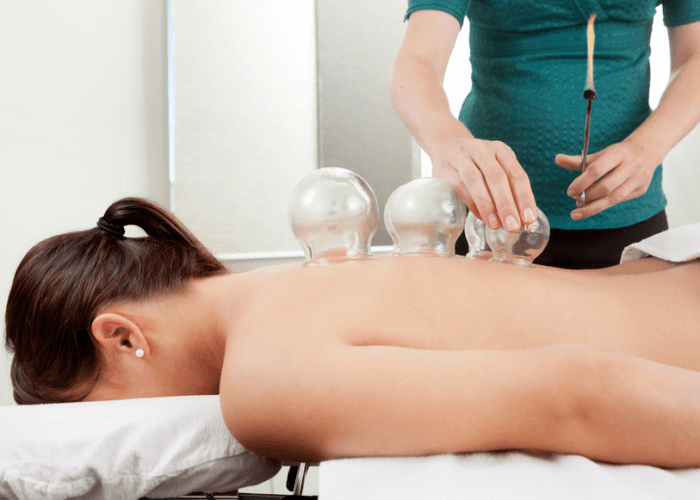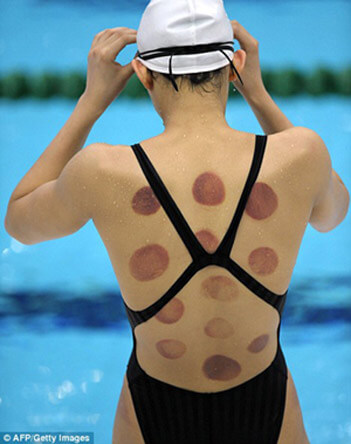Source of article: https://www.swimmingworldmagazine.com/news/a-look-back-when-cupping-therapy-and-those-purple-bruises-became-a-curiosity/
Cupping Therapy on Swimmers
During this stall in competitive action, Swimming World will occasionally take a look back at epic races, interviews and phenomenons in the sport. Today, we look back at the recovery technique known as cupping, which attracted considerable attention ahead of and at the 2016 Olympic Games in Rio de Janeiro.
By Wilson Josephson and Allie Clark, Swimming World College Interns
Athletes at the Jean Freeman Invitational in December may have noticed bruises on many of the swimmers from Gustavus Adolphus College (GAC). The mysterious bruises were perfect circles, each a few inches across. Some swimmers had them on their shoulders and some on their backs, but the bruises were always the same.
Intrigued by the uniform bruises, your trusty Swimming World interns have done a little investigating. It turns out that the bruises are from a new recovery technique called “cupping.”
Cupping therapy had been in the news over the previous summer, as Natalie Coughlin, Nathan Adrian, and others from Cal Aquatics used the technique to help their recovery after especially brutal practices.

Photo Courtesy: Isthmus Acupuncture
The therapy almost became a cultural phenomena with many swimmers sporting the concentric purple circles across their shoulders and backs. Michael Phelps touted his own bruises on night two of the 2016 Rio Olympic Games when he helped the USA men win gold in the 400 free relay and take back the title of Olympic Champion from France.
Gustavus head coach Jon Carlson and swimmer Kayla Hutsell, who began using cupping on her back and shoulder at the beginning of this season, offered some insights into the process.
Cupping employs suction to tug on the tightest muscles, stretching the fascia. The vacuum lifts the skin off the muscle or bone, allowing the blood vessels to expand and more blood to flow to the targeted area. Increased blood flow is believed to help the body recover faster.
Carlson says this separates cupping from other recovery methods.
“One advantage that cupping has over other methods is that it’s one of very few treatments that are decompressive, rather than compressive, in nature.”
“Basically, the athletic trainers use big cups and suck the air out of them, which in turn sucks our skin up into the cup,” says Hutsell. The process only takes about five minutes – just enough time for the suction to break small blood vessels and leave a colorful bruise.
“It kind of feels like someone is just pinching your back for five minutes,” Hutsell reports. “But the release is incredibly worth the five minutes of pain.”
GAC began using cupping after training sessions this fall.
“The athletic training staff started experimenting with the effects of cupping over the summer,” says Carlson. “They introduced it this fall, slowly at first, but they quickly expanded the program due to its success and popularity with athletes.”
The training staff recommends cupping to student-athletes on a case-by-case basis. Coach Carlson describes it as a “hit-or-miss” treatment.
“We really try to facilitate whichever recovery process works for the individual athlete. Some really benefit from the treatment. Others have tried it, and have moved on to other forms of treatment.”
Dani Klunk is an example of an athlete who has found cupping therapy to be an important relief.
“It doesn’t cure her problem,” says Carlson. “But it can help decrease the symptoms of the larger problem. With the relief from cupping, Dani can still train and race with an intensity that wouldn’t otherwise be an option.”
Hutsell says that she has been impressed with cupping’s effects on her back.
“It helps recover areas that are very tight with knots,” she says. “I like it for my back, but the relief time for me is pretty short. The pain usually comes returns within eight hours.”
Cupping therapy is just one more tool in the arsenal of the Gustavus team.
“We’re always searching for ways to help our student-athletes perform at their best,” says Carlson. “One motto on our team is ‘a healthier swimmer is a happier swimmer is a faster swimmer.’ If cupping helps to make even just a few of my athletes healthier, happier, and faster, then I’m all for it!”
If you’re curious about finding a new edge to help you recover faster and train harder, check in with your athletic trainers about the possibility of cupping. And have no fear, Hutsell has assured us that the bruises don’t hurt at all. Though they do make quite the fashion statement!







